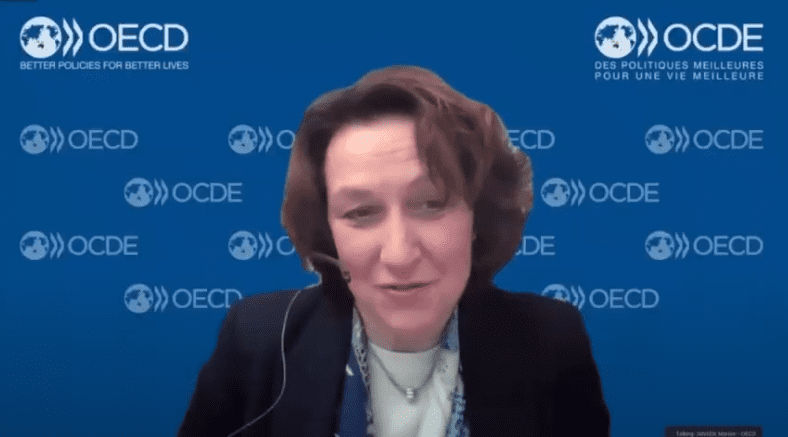
OECD’s Marion Jansen addressed the ABARES Outlook 2024 event via livestream from France.
AUSTRALIAN grain growers will be called on to produce more with less in an increasingly volatile pricing market and changing climate, according to OECD director trade and agriculture Marion Jansen.
Speaking at the ABARES Outlook 2024 event held at Canberra last month, Dr Jansen said growers around the world would need to increase productivity enough to feed an increasing population, as well as help meet sustainability goals adopted under the Paris Agreement.
Adopted in 2016, the Paris Agreement is a legally binding global treaty which includes targets to limit global warming to 1.5 degrees Celsius by reducing greenhouse gas emissions by 43 percent by 2030.
Finalised a year earlier, the United Nations has adopted global Sustainable Development Goals to achieve by 2030.
Also known as the 2030 Agenda, its key target includes ending world hunger, achieving food security and improved nutrition, and promoting sustainable agriculture.
Australia is a signatory of the Paris Agreement and, although not a member country, has committed to implementing the goals of the 2030 Agenda and to assist in global efforts.
Dr Jansen said this international vision was “big burden and a heavy responsibility on the shoulders of the agricultural sector”.
“The challenge that we have in front of us is huge,” Dr Jansen said.
“More needs to be invested, more needs to be produced and more needs to be done to become more environmentally friendly in a context of instability in prices…and the context of higher input costs, especially in energy and fertilisers.”
She said the industry would have to find technologies and practices to make consistent yield improvements while also reducing its reliance on synthetic fertilisers.
Dr Jansen said the OECD simulated how much global grains industry productivity would need to grow in order to both reach the goal of “zero hunger” and reduce greenhouse-gas emissions.
“We calculated that productivity growth would have to be 28pc in the next ten years.
“It represents a tripling of the productivity growth of ten years ago.
“Frankly speaking, that tripling is pretty much impossible to achieve.”
She said this would equate to a 24pc increase in crop yields and a 31pc rise in animal productivity over ten years.
Dr Jansen said these productivity goals would need to be achieved in an environment of reduced commodity prices and input price volatility.
“We expect there is going to be a continued decline in the real price of agricultural commodities.
“We expect that to continue…however, we expect there to be continued uncertainty in markets.
“Instability in fertiliser markets or instability in energy markets through fertiliser markets will affect crop prices, feed prices and the prices of animal products.”
Increased reliance on crops
Staple crops, such as rice, wheat, corn and tubers or potatoes, will play a larger role in feeding future populations than first thought, according to OECD data.
Dr Jansen said the OECD originally expected that diets of developing countries with increasing levels of consumption would converge to include staples of richer nations, namely animal products.
“In the developing world, we see in regions like sub-Saharan Africa and south and south-east Asia those staple crops are representing two-thirds of the diet.
“The origin of proteins in consumption is also very different across regions and we continue to see that the majority of proteins in low income and also low to middle income countries comes from staple crops.
“This is the case now and we expect it to continue to be the case in the future in the coming ten years.”
Small gains
Dr Jansen while the challenge for the grains industry appeared insurmountable, global trends indicated that the sector’s productivity and greenhouse gas emissions were heading in the right direction.
“We expect crop production increases to be driven rather by productivity improvements than the expansion of land use.
“This is important…because a change in land use, so using more land for crop production is one of the most important drivers of greenhouse gas emissions.”

Projections for crop production growth to 2032. Most growth is expected to come from yield increases rather than more land use. Source: OECD
She said there has been some improvements to greenhouse gas emissions but not enough to result in a decrease in emissions.
While the biggest source of greenhouse gas emissions was ruminants, Dr Jansen said the use of synthetic fertilisers was also an important source of growing emissions.
She said investment would be the key to reducing emissions and increasing productivity.
She said the world should also target increasing productivity and technology uptake in developing nations.
“Further efforts have to go in the direction of increasing global productivity further.
“We need a significant increase in productivity from agriculture that can notably be achieved by increased technology transfer to the regions with lower productivity right now, mainly in the developing world.”
Grain Central: Get our free news straight to your inbox – Click here



HAVE YOUR SAY